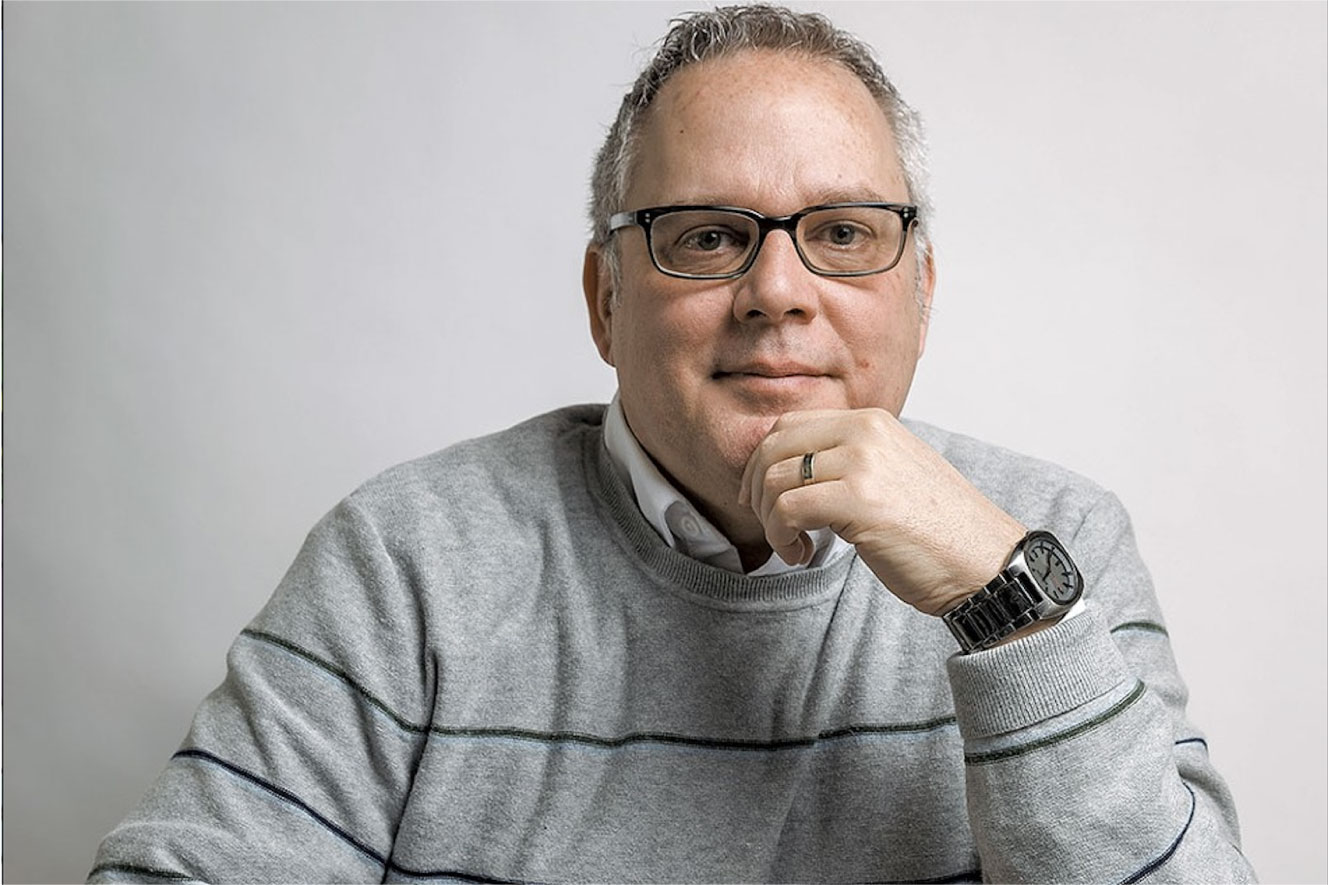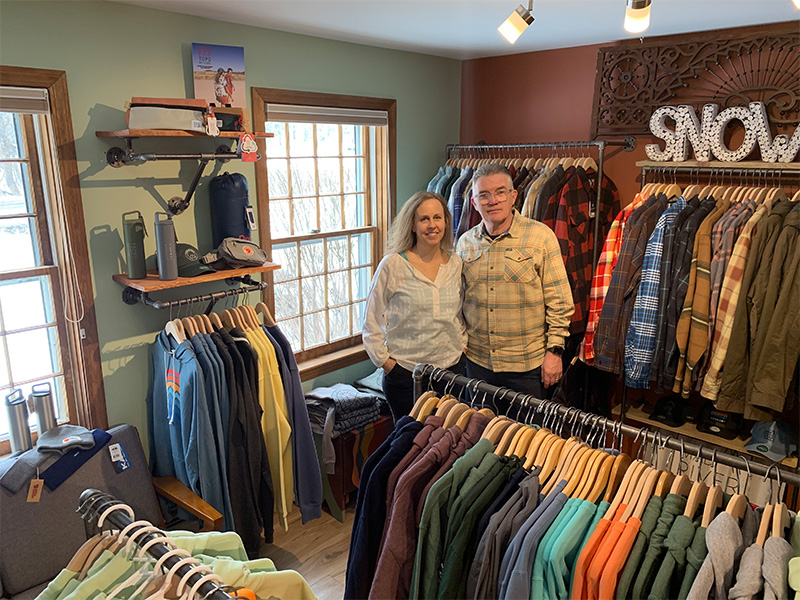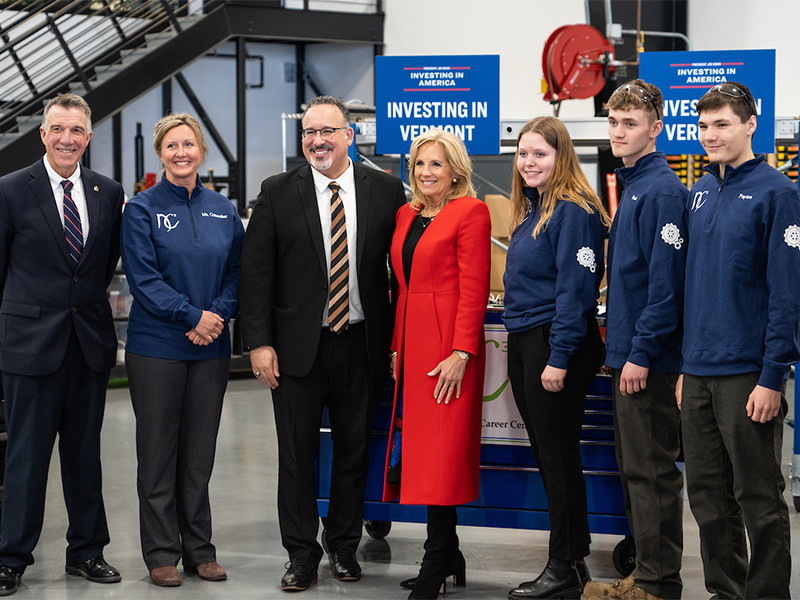By MOLLY WALSH | Photo by OLIVER PARINI
Burlington entrepreneur Rob Conboy has high hopes for the object in the palm of his hand. The gray nugget he held on a recent afternoon looked like a stone but weighed no more than a sponge.
The pseudo rock, which resembles pumice, was foam-glass aggregate, made from recycled glass that had been ground to powder, mixed with a foaming agent, baked into cakes and broken into a light, insulating substitute for gravel. Conboy imported this particular sample from Germany, but his startup company is planning to open a St. Albans plant to bring the technology — and its waste-reducing potential — to Vermont.
Someday, Conboy said, the plant could convert 9,000 tons of discarded glass each year — roughly the amount Chittenden County currently generates — into an ultralight fill that he has been selling for use under building foundations. He calls the material, and the company, Glavel.
Conboy’s operation would be the second of its kind in the United States. By manufacturing in Vermont’s Rail City, the company would also have access to raw materials and customers in Québec. But Glavel faces plenty of challenges, including potential competition in its own backyard. The other American manufacturer, Pennsylvania-based AeroAggregates, recently announced plans to expand into the New England market. Sales-wise, both companies have a lot of educating to do. While Europeans have used foam-glass aggregate for more than two decades, it is still a relatively new product here and more expensive than stone gravel.
Nevertheless, Conboy thinks his timing is right. In the wake of China’s decision in 2018 to stop accepting most foreign waste, U.S. recycling centers are struggling to find any market for the tons of glass they collect.
It’s time to stop thinking some third world country is going to take our recycling and “magically turn it into something we can order on Amazon,” Conboy said. “We’re going to have to find solutions here, and not ship off our waste.”
Cathy Jamieson, solid waste program manager at the Vermont Agency of Natural Resources, agreed. Given the lack of demand for Vermont’s supply of recycled glass, it’s encouraging to see a company like Glavel proposing a new use, she said.
“I think it’s always a good thing when we can try to have what Europeans are calling the circular economy,” she said, referring to the practice of finding a useful new life for discarded products. In Europe, at least a dozen plants transform curbside glass recycling into gravel-sized aggregate that is used as fill under building foundations and in transportation projects ranging from roads to tunnels. (“Aggregate” is a term for a wide variety of coarse, crushed material used in construction, including sand, gravel, pulverized concrete and synthetics such as Glavel.)
The executives at Vermont’s largest trash and recycling company, Casella Waste Systems, are also cheering on Conboy.
“Quite frankly, we have to find something to do with glass,” said Joe Fusco, vice president of Rutland-based Casella.
Glavel plans to lease space in a new, $2.2 million building in the St. Albans Industrial Park; Franklin County Industrial Development is financing its construction. Glavel will then spend its own money — Conboy won’t say how much — to fit up the building with kilns and other equipment ordered from Europe.
Pending a state environmental permit, the building could be ready by summer, according to Tim Smith, executive director of the Franklin County development group. “We as an organization think it’s a great project based on what’s happening with recycled glass currently, which is little or nothing,” Smith said. “This is an opportunity to use it productively.”
From Beef Jerky to Burton
Late afternoon sun streamed through the windows of Conboy’s small Main Street office, a few doors down the hill from Burlington City Hall Park. The light illuminated a hunk of glass aggregate on his desk, as well as jars of glass powder and glass nuggets that he uses to illustrate the process of transforming smelly, spent beer bottles and mayonnaise jars into fill that insulates tunnels and goes under green roofing.
Conboy’s journey from California State University accounting major to green-biz whiz began in the early ’90s — with a stint selling beef jerky for Pacific Sun Industries.
It was less glamorous than “riding the dot-com wave” as his peers were doing, but he liked the work, which sent him to places like Guam and Japan to expand markets for the snack food. “It was real,” recalled Conboy, now 51, who discovered he liked sales as much as studying the process of creating and packaging vast amounts of dried beef. “I liked the idea of making things,” he said.
He learned about marketing, shipping and manufacturing and worked up to business operations analyst, reporting directly to the CEO. All of that looked great on his résumé when, after five years in California, he started looking for a job on the other side of the country.
“It was a big leap,” said Conboy, who grew up in the San Francisco Bay Area. “I was wanting to make a transition, and there was an Outside magazine article, and Burlington was ranked sixth or something in terms of places to live and enjoy the outdoors.
“I was a snowboarder and really wanted to work for Burton,” he continued. “Every Wednesday they would post new jobs and … I would see if there was something that I could do.”
Conboy joined Burton as the accounts payable supervisor, a step down from his California job. But once hired, he rose through the ranks to a budget analyst job, then into global sales.
Looking back, Conboy said working at Burton taught him to value innovation and not fall back on “saying that’s the way we’ve always done it. The change was constant. You were expected to be nimble enough to handle it.”
From Burton, Conboy moved to the green household product company Seventh Generation. “They were on a growth trajectory, and we were introducing new product lines, so it was a really amazing time to be at Seventh Gen,” he said. The company helped finance his pursuit of a master’s in business with an emphasis on sustainability at the University of Vermont. Under the arrangement, Conboy’s tuition reimbursement increased with his GPA. “So I got As,” Conboy said.
He left the company to start consulting for the sustainable business sector and wound up going to work for one of his clients, Burlington alternative energy company Draker Labs, now a subsidiary of the international company AlsoEnergy.
Conboy helped the young company attract early-stage investment and left a few years later, working briefly at a thermal energy storage business. Then, in 2012, he co-launched a consulting company called Better that matches investors with people who want to build energy-efficient buildings.
He discovered foam-glass aggregate while traveling abroad, learning how other countries turn their curbside glass into a building material with an established track record. “This is not an R&D, science-experiment type of thing,” Conboy said.
Two years ago, he founded Glavel Inc. The product’s good reputation in Europe, coupled with the growing dilemma of what to do with U.S. glass recycling, convinced him it could work here. “The time had come,” Conboy said.
Since 2018, he has been selling German foam-glass aggregate to test the market and cultivate future clients for his own product. He’s also been raising capital from private investors — how much, he won’t say — and government.
Last year, Glavel was awarded a Vermont Employment Growth Incentive grant of an estimated $350,000 on the condition that the company meet its employment and revenue goals.
Headquarters will be in Burlington, Conboy said. The company currently has five employees — three local and two who work remotely from outside Vermont — and the St. Albans plant expects to add 12 to 15 more, according to the CEO.
Manufacturing would start in phases, he continued. In the beginning, Conboy plans to make aggregate with glass powder from a Canadian company. Then he’ll buy the machinery required to clean and mill Vermonters’ curbside glass recycling instead.
The goal is to get the product to market, then localize the process of making it.
“It’s a matter of when, not if,” Conboy insisted.
Aero Dynamics
Conboy’s only U.S. competition — AeroAggregates of Eddystone, Pa. — began selling foam-glass aggregate in 2017 and now makes mountains of it from curbside recycling materials collected in Philadelphia and the surrounding area.
A Seven Days reporter visited the plant last week in an old factory building at the former Eddystone Rifle Plant. During World War I, it employed 15,000 people and produced 1.9 million rifles. But most of the factory has been razed, and the area was a brownfield when AeroAggregates moved into one of the remaining structures, a 97,000-square-foot building where rifle gunstocks were once made.
Last week, piles of foam-glass aggregate formed enormous gray mounds that rose 45 feet just outside the plant, while the factory cranked out more. Inside, a film of white glass powder coated the floor, and the loud hum of air compressors and clanking conveyor belts filled the air.
A whiff of decay hung over the place, which AeroAggregates cofounder and CEO Archie Filshill referred to as the “frat party” smell. It was coming from curbside glass recycling waiting to be cleaned in a walled-off section of the building. Chicken bones have a way of arriving in empty beer bottles, and sticky food and beverage residue often cling to various glass containers, he explained. After the material is cleaned, it travels on conveyor belts into the main factory room to be milled into a fine powder.
Workers, some wearing masks over their mouths to keep out the dust, did maintenance on the funnel-shaped steel containers where the glass is ground.
The goal is to get it to a consistency “a little bit more gritty than talcum powder but finer than sand,” said Filshill.
The glass powder is then piped to a large silo outside the building to await conversion into gravel-like aggregate as orders dictate.
A pipe carries the powder back into the factory, where it is combined with a powdered foaming agent in a galvanized steel mixer. The material is then spread onto a thin layer of fiberglass textile and taken on conveyor belts into one of two kilns with multiple chambers that get as hot as 1,700 degrees Fahrenheit.
While the material bakes, the foaming agent creates tiny bubbles that are trapped in the glass, giving the material its high insulating value.
When the cakes emerge from the kiln into the factory air, the temperature change creates thermal stress that cracks them into chunks. Conveyor belts carry the pieces out of the building, where they drop roughly 20 feet to the ground, breaking into slightly smaller, gravel-size chunks.
“Our crushing and size reduction is really done by nature rather than by mechanical equipment,” Filshill said.
On its website, the privately held company touts the fact that the recycled materials it uses annually are equivalent to 140 million used glass bottles — but most buyers aren’t seduced by the company’s eco-friendly marketing.
“We do what we think is this incredibly neat, green product,” said Filshill. But, he explained, “We don’t get a single project because of that.”
Most buyers choose foam-glass aggregate because it is lightweight, easy to move, non-absorbent and highly insulating. That makes it a good choice for construction on soft soils, because it creates less pressure than gravel on retaining walls and other barriers, and for protection around underground utilities.
Filshill said one of the biggest challenges has just been getting the transportation and construction industry familiar with the gravel alternative. But once companies try it, they are more open to using it again, and the demand is building, said the CEO, who declined to comment on company revenue or profits.
Among the company’s biggest projects: providing fill for the redevelopment of the Camden, N.J., waterfront and for Pennsylvania Department of Transportation road projects, including on- and off-ramps on Interstate 95.
Aero has seven patent applications pending for its manufacturing process, which Filshill said is a refined version of the European approach. He declined to let a reporter see the glass-cleaning section of the plant, saying his dry-clean method is proprietary.
Curbside recycling must be uncontaminated to be made into usable aggregate, and this is one of the big manufacturing challenges, Filshill said.
“There’s glass everywhere, but to get it clean is a trick and a half,” he said.
Filshill is competitive. While building AeroAggregates, he has followed Glavel’s progress and met with Conboy. Filshill said he offered to partner with the Vermont company but that Conboy wasn’t interested.
Not so, said Conboy, who said he offered to sell Filshill’s foam-glass aggregate in lieu of German product during Glavel’s startup phase, but Filshill turned him down.
Last week, Filshill announced that AeroAggregates plans to build two additional plants this year, one in the Southeast and one in the Northeast. “Yes, absolutely,” Vermont is a potential site for the $13 million plant, Filshill said.
The company is not worried about Glavel taking away business. “It doesn’t really change our plans,” Filshill said, adding that he has had talks with Casella about obtaining recycled glass from its outlets throughout the Northeast.
Conboy’s position: There is enough recycled glass and plenty of room for other foam-glass aggregate makers in the U.S. He said that while AeroAggregates might build a plant in New England, he strongly doubts it will be in Vermont or this year.
Too Much Glass
The Green Mountain State faces a growing dilemma when it comes to dealing with the glass that can’t be pitched into the dump under Vermont’s Universal Recycling Law.
Much of what Vermonters toss into blue recycling bins or rubber totes goes to the two recycling facilities — in Williston and Rutland — operated under contract by Casella.
For more than a decade, the Chittenden County Solid Waste District has crushed a large portion of the Williston facility’s glass and sent it to outlets such as Frank W. Whitcomb Construction in Colchester, which uses it for concrete, as well as in a mix with natural stone gravel for general fill — a product that is nothing like foam-glass aggregate, according to Conboy.
It’s so difficult to find outlets, in fact, that CSWD has resorted to depositing crushed recycled glass on its property in Williston. Last year, the District #4 Environmental Commission issued an opinion saying that CSWD should have obtained permits before dumping thousands of cubic yards of crushed glass on its property. The previous year, 2018, the Vermont Agency of Natural Resources had ordered CSWD to stop discarding the crushed glass on-site and referred the case to the Vermont attorney general.
CSWD maintains that the glass was used for a retaining wall and other purposes that are allowed under state law. The case is pending. “I can’t say much other than that we’re talking with Chittenden Solid Waste, and it’s moving in the right direction,” said Attorney General T.J. Donovan.
Sarah Reeves, executive director of CSWD, wrote in an email that “we take the allegations very seriously and are working with our attorney, the Attorney General’s office, and the Agency of Natural Resources to reach a resolution regarding this issue.”
Finding outlets for glass remains a large challenge. CSWD had planned to ship glass to 2M Ressources in Canada this year, as it had in years past. But late last year the company canceled the arrangement. So CSWD is sending the glass to Patriot Recycling in Raynham, Mass., at a cost of approximately $115 a ton, compared to the $20 a ton it had budgeted for shipping to 2M, according to Reeves.
Reeves said Glavel’s proposed plant could help solve a major dilemma. “We’re hopeful they’ll be able to get their process up and running and be successful so that there are more opportunities for the region to direct glass into different types of recycling and beneficial reuse.”
Filling the Gaps
Glavel sells foam-glass aggregate at list prices starting at $65 a cubic yard, plus shipping.
Crushed stone is measured by weight, not volume, but most industry sources concede that foam-glass aggregate is more expensive.
But because it has insulating value, contractors do not need to use foam insulation on top of it, as they often do with rock gravel, Conboy said, thus two steps can be reduced to one.
Will that be enough to convince someone like Steve Theriault, president of South Burlington general contractor Wright & Morrissey?
“Construction guys tend to be a little skeptical,” said Theriault. To his knowledge, Wright & Morrissey has rarely if ever used foam-glass aggregate in projects. “If it’s not broke, don’t fix it.”
When it comes to fill, “dirt works pretty good, crushed stone works pretty good,” Theriault said, adding that switching to foam-glass aggregate might require a persuasive sales pitch.
“As in most things in life, you have to be convinced to use it; you have to have a reason,” he said.
But others are more optimistic about the future of Glavel. “I think it’s fantastic,” said Arthur Chukhman, an architect at Duncan Wisniewski Architecture in Burlington who specializes in energy efficient design.
Chukhman ordered German foam-glass aggregate from Glavel to go under the foundation of a 2,100-square-foot addition to his 150-year-old house on North Winooski Avenue.
It is the first certified passive house in Burlington, for which he and his wife carefully selected all the materials from recycled products or products that store carbon.
Compacting the foam-glass aggregate to create a level layer under the foundation took longer than it would have taken to compact gravel, which settles faster because it is heavier. But employing the Glavel-ordered product meant he didn’t need to use foam insulation, and the minor challenges were worth the effort, he said.
Chukhman said the price came in roughly 15 percent higher than a traditional treatment.
Depending on how one calculates the environmental cost of single-use bottles littering the landscape, that surcharge may be worth it.
As Conboy said: “Anything we can do to use our glass in an upcycled way, I think we need to be supporting.”
A version of this article first appeared on sevendaysvt.com and in Seven Days newspaper, a Burlington-based newsweekly published on Wednesdays and distributed for free at more than 1,000 locations in northern and central Vt. and Plattsburgh, N.Y.




